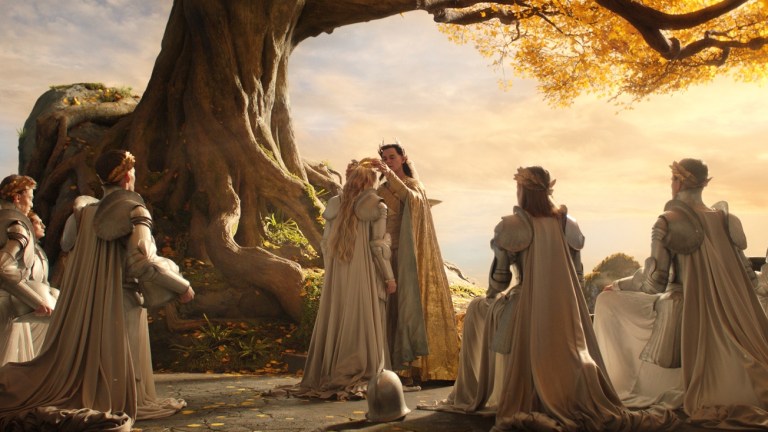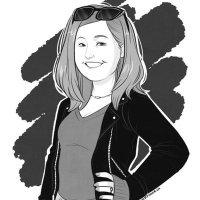Lord of the Rings: The Rings of Power’s Costumes and the Challenge of Reimagining Tolkien’s Second Age
Exclusive: Lord of the Rings: The Rings of Power costume designer Kate Hawley breaks down how she used Tolkien's work to bring the look of Middle-earth's Second Age to life.

J.R.R. Tolkien’s The Lord of the Rings has largely helped define the idea of epic fantasy fiction for generations of readers since its initial publication in 1954, and its impact is still keenly felt in almost every popular piece of fantasy-adjacent media we see today. And director Peter Jackson’s Oscar-winning trilogy of films has, in its turn, basically come to define the idea of “Tolkien” in popular culture, turning even the most casual of viewers into hardcore lore experts on the lifestyle choices of hobbits and orcs. But Tolkien’s most famous work actually concludes his massive fantasy history of Middle-earth, the bulk of which takes place well before Bilbo Baggins ever steals a powerful piece of jewelry from creature named Gollum.
Prime Video’s The Rings of Power explores the Second Age of Middle-earth, which is set millennia before the movies, and follows the story of Sauron’s initial rise to power, the creation of Mordor, and the forging of the great rings—19 given to the races of elves, men, and dwarves and the One made to rule them all. And according to Kate Hawley, the costume designer for Rings of Power, a big part of her job was to find a way to honor what has come before in the world of Middle-earth while charting a new path—one that has never actually been represented onscreen before.
“I’ve read the books. I went to those films and the trilogy was beautiful,” Hawley tells Den of Geek when we catch with the designer at SDCC 2023. “Gandalf and so much of it was walked out of those books, but we didn’t have that for this series. J.D. [Payne] and Patrick [McKay, showrunners of Rings of Power] definitely wanted something that shifted away and suggested this earlier time. So we started by referring to the Third Age and then referring back to the First Age and look[ing] at the whole story arc.”
Tolkien’s The Silmarillion chronicles much of the earliest history of his fantasy universe, stretching from the very beginning of time to the downfall of Morgoth (Sauron’s evil predecessor) at the end of the First Age. Both The Hobbit and the Lord of the Rings trilogy take place during the Third Age, a period that concludes with the ultimate defeat of Sauron in the War of the Ring. As for the Second Age covered in The Rings of Power, Tolkien never specifically set any of his books during that time period, though he made frequent references to the events that took place during it. It’s an era that contains, among other things, the fall of the great island kingdom of Numenor and Sauron’s first defeat in the War of the Last Alliance. (The latter, of course, is memorably narrated by Cate Blanchett during the prologue to Jackson’s The Fellowship of the Ring.) But for Hawley, conceptualizing the time period of Rings of Power meant creating a world that felt connected to what we know of the ones that came both before and after it.
“I think we approached [everything] in a very organic way to relate more to the First and Second Age feeling that we were wanting to create. It has a sort of rawer quality to it,” she says.
As we’ve already seen on the Prime Video series, the Second Age is also the period during which the great Rings are forged, and although only three of them exist on the show so far, they’re hardly the only significant pieces of jewelry onscreen. And that’s a choice that’s quite intentional.
“There are the Rings, which are obviously the main part of the world, but there are all these supporting elements too—all of Tolkien’s work and references to the characters, it’s obsessed with jewelry,” Hawley explains. “You look at the elves and Valinor and the vanity and everywhere you read there’s talk of jewelry and discussion about it. He talks about elves being born on shores of pearl and he doesn’t necessarily mean that in a literal way, but he’s always talking about ways to reflect the light and those qualities. There’s jewelry everywhere woven into clothes.”
Much of the elves’ clothing, specifically, in Rings of Power is meant to “heark[en] back to the world of Valinor” and help illustrate just how different these particular immortal beings are from the ones we meet later on in Lothlorien and Rivendell during The Lord of the Rings.
“We were trying to find those things that would make it a unique language that they would come up with, [and] also suggest age and time past,” Hawley explains. “Gil-galad—those particular elves, have been there since the First Age, so you’ve got to reference that world, and it was quite full on when you read some of the descriptions of it.”
The elves of Rings of Power aren’t the only race from the world of Tolkien that looks a bit different than modern audiences might remember from the movies. Though dwarves play key roles in both The Hobbit and The Lord of the Rings, we don’t see much of the world these characters inhabit, something that is absolutely not the case on the Amazon series.
“The dwarves represented such a rich culture when you got to know them,” Hawley says. “We came up with dwarven priests and gardening dwarves and all these things that Gimli talks about in Khazad-dum before it becomes Moria. And you learn about the dwarves and their secrets and ancient rituals and there’s lots and lots of things that came up in the research that allowed us to explore them. Dwarves became the most amazing characters to design, really.”
Asked to avoid “a huge amount of prosthetics” when coming up with their ideas for what Second Age dwarves should look like, Hawley and her design team decided to emphasize “character more than anything.”
“It was partly [done] through casting,” she says. “We [also] created things that felt dwarvish in their jewelry—back to the jewelry!—with gold ears and things that could help in a realistic way when it came to getting through timelines and deadlines, but also be part of the culture.”
In Tolkien’s world, dwarves inhabit something of a middle ground between the immortal elves and the short-lived race of men. Dwarves believe themselves to be created by Aule from rock and fire, a mix of the eternal and the immediate, beings that are exceptionally long-lived but who also understand that everything ends, and all must eventually come to dust.
“We did many, many concepts that included all kinds of things—physicalities, beards, how much hair, how much not,” she says. “Dwarves have their own written richness and there’s this whole allusion to stone, and [so it was a question of] how do we find a new way into that language with stone and jewels [to represent] this golden age of dwarves.”
Hawley cites the Middle High German epic poem The Nibelungenlied as well as Scandinavian sagas as influences for some of her ideas—particularly when it comes to how to depict dwarven women onscreen for the first time.
“We looked at their physicality as having a softness to it, but also a strength, so we use materiality in that way,” she explains. “The women sort of became an idea of water over a stone of men, so to speak. And Disa’s eyes reflecting the gold—you know Tolkien talks a lot about the dwarves reflecting the light of the fire in their eyes and their god, Aule, so it’s sort of trying to pull all of that back in, really.”
Lord of the Rings: The Rings of Power is streaming now on Amazon Prime Video.
